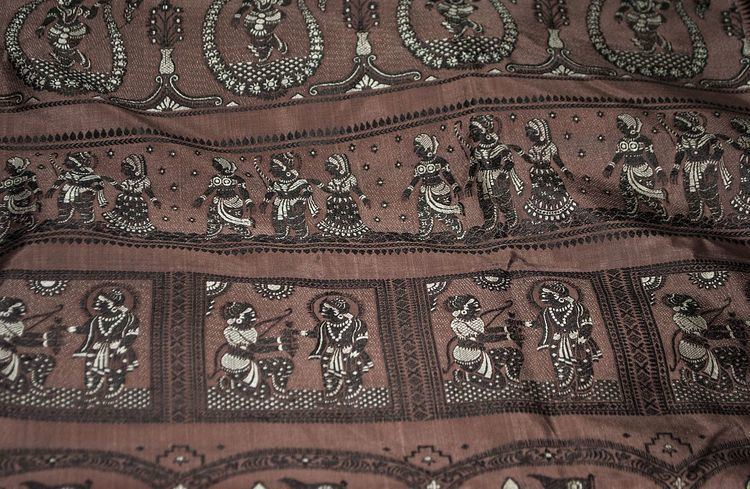 | ||
Baluchar Sari or Baluchuri Sari(Bengali:বালুচরী শাড়ি) is a type of sari, a garment worn by women across India and Bangladesh. This particular type of sari originated in Bengal and is known for depictions of mythological scenes on the pallu of the sari. It was mainly produced in Murshidabad but presently Bishnupur and its surrounding places of West Bengal is the only place where authentic Baluchuri sarees are produced. It takes approximately one week to produce one such sari. The Baluchari Sari has been granted the status of Geographical indication in India.
Contents
History
In the history of textile in Bengal, Baluchari or Baluchuri came much after Maslin. Two hundred years ago Baluchari was used to be practised in a small village called Baluchar in Murshidabad district, from where it got the name Baluchari. In the eighteenth century, Murshidkuli Khan, Nawab of Bengal patronized its rich weaving tradition and brought the craft of making this sari from Dhaka to the Baluchar village in Murshidabad and encouraged the industry to flourish. After a flood in the Ganga river and the subsequent submerging of the village, the industry moved to Bishnupur village in Bankura district. Baluchari Sari made of tassar silk and a thousand years old when the Jagat Malla king rule in Mallabhum. But this flourishing trend later declined, specially during British rule, due to political and financial reasons and it became a dying craft as most of the weavers were compelled to give up the profession.
Later in the first half of twentieth century, Subho Thakur, a famous artist, felt the need of recultivating the rich tradition of Baluchari craft. Though Bishnupur was always famous for its silk, he invited Akshay Kumar Das, a master weaver of Bishnupur to his center to learn the technique of jacquard weaving. Sri Das then went back to Bishnupur and worked hard to weave Baluchari on their looms.
Once Bishnupur was the capital of Malla dynasty and different kinds of crafts flourished during their period under the patronage of Malla kings. Temples made of terracotta bricks were one achievement of these rulers. A major influence of these temples can be seen in Baluchari sarees. Mythological stories taken from the walls of temples and woven on Baluchari sarees, is a common feature in Bishnupur.
Process of making the Baluchari or Baluchuri
The production process of Baluchari or Baluchuri can be divided into several parts:-
Cultivation of cocoons:- Since the discovery so many years ago that the fibre or filament composing the cocoon of the silkworm can be constructed into a beautiful and durable fabric, silkworms have been bred for the sole purpose of producing raw silk.
Processing of yarns:- To make the yarn soft, it is boiled in a solution of soda and soap and then dyed in acid colour, according to the requirement of the saree. The yarn is stretched from both the sides in opposite directions putting some force with both palms. This process is needed to make the yarn crisper.
Motif making:- Making of the motifs for 'pallavs' and other part of Baluchari is in itself an intricate process. The design is drawn on a graph paper, it is coloured and punching is done using cards. After punching, these cards are sewed in order and fixed in the jacquard machine.
Weaving:- After jacquard loom has been introduced, weaving of a Baluchari saree takes five to six days to get completed. Two weavers work on it on shifting basis.
Baluchari thus prepared becomes the sign of aristocracy, the attire of status. Maintenance of quality of Baluchari saree is taken care of precisely. The quality is checked from the stage of dying of the yarn to the packaging of the saree.
Motifs: Themes and Variety
Baluchari saris or locally called Baluchuri saris, today often have depictions from scenes of Mahabharat and Ramayana. During the Mughal and British eras, they had a square design in the pallu with paisley motifs in them, and depicted scenes from the lives of the Nawab of Bengal featuring women smoking hookahs, nawabs driving horse carriages, and even European officers of the East India Company. It would take two craftsmen to work for almost a week to produce one sari. The main material used is silk and the sari is polished after weaving.
While there isn’t a lot of variation in the method of weaving used today, balucharis can be broadly categorized based on the threads used in weaving the patterns:
Use
These saris were mostly worn by women from upper class and Zamindar households in Bengal during festive occasions and weddings.
Organic Baluchari
With the changing time, the baluchari saree gets a make over & a touch of eco-friendliness in terms of the used yarns & colours. Cotton Kapas is spun with fibres of banana plants and bamboo shoots and the dyes are extracts of fruits, flowers, leaves, and vegetables such as pomegranate, jamun, neem fruits and leaves, basil leaves, turmeric, marigold flowers, mangoes and others. The organic baluchari cotton sarees were displayed in the sari fair organised by Rang Mahal, a forum of weavers from Nadia district in West Bengal. However, with GI certification of Baluchari or Baluchuri sarees with reference to Bankura district of West Bengal in India, it is now not permitted to use the term Baluchari or Baluchuri for any other similar product based on cotton or any other material.
Display & felicitation
The Baluchari or Baluchuri saree was one of the award winners for the main weaving styles amongst thirty four National Awards for the years 2009 & 2010 present by the Hon. President Pranab Mukherjee
Baluchari or Baluchuri Saree of Bankura is also being showcased at the India International Trade Fair organised at New Delhi. The pavilion of West Bengal,has prominently displayed those products of handicrafts and handloom sector which have been recognised for their unique nature keeping the theme "Skilling India" in view.
